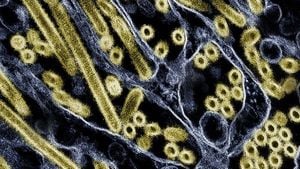When it came to Halloween 2024, mixed experiences filled the air across North Jersey neighborhoods as trick-or-treating unfolded under unusually warm autumn skies. Despite temperatures nearing record highs, the turnout for traditional door-to-door candy gathering appeared to vary greatly from one area to another, leaving many residents pondering the future of this beloved holiday custom.
On one hand, some neighborhoods experienced vibrant scenes packed with children swapping costumes and buckets of candy, but others were surprisingly quiet. For example, on the NorthJersey.com Instagram page, local residents shared their thoughts, and the results varied dramatically. One resident from Wayne lamented, "I’m in Wayne and not one trick-or-treater. It’s my favorite holiday, and it just makes me so sad." A fellow commenter echoed similar sentiments, declaring, "First time we ever got zero. So sad." This seemed to be the case for several communities, where the usual excitement of Halloween turned to disappointment.
Interestingly, not every area faced the same fate. Residents from places like Rutherford were quick to share more positive experiences, saying, "Lots of kids out in Rutherford! The east side was pretty busy all afternoon - little kids, big kids, parents all having a good time." Another resident from the Jefferson/Lake Hopatcong region noted, "We ran out of candy around 7:30! Groups of kids with parents and older teens, too! All so respectful and polite." Clearly, the allure of Halloween remained strong for some neighborhoods, as the joy of collecting candy still prevailed.
Some residents suggested factors such as the rising popularity of 'trunk-or-treating' may have contributed to the decline. Unlike traditional trick-or-treating, trunk-or-treat events take place often at schools or churches, where decorated vehicles serve as candy stations. This provides children with a contained environment to gather treats, making it easier for parents to supervise. "Trunk or treat ruined everything; people got lazy," said one Instagram user, showing nostalgia for traditional trick-or-treating experiences.
The oddity of 2024 Halloween’s date also played its role. Having Halloween on the middle of the week might have deterred some families from participating due to scheduling challenges. Yet, as one optimistically pointed out on social media, next year Halloween will fall on Friday, allowing families to relish the festivities without weekday worries: "Great weather and turnout in Towaco! Way to go kids!"
Meanwhile, the Des Moines metro area faced its own Halloween trial. For the first time since 1938, cities including West Des Moines, Clive, and Des Moines shifted trick-or-treating from the traditional "Beggars' Night" to the evening of Halloween itself, thanks to unforeseen severe weather. This unexpected switch raised discussions among residents about what future Halloweens should look like.
Interest from the community was palpable, as local officials launched surveys to gauge preferences on trick-or-treating dates. West Des Moines Mayor Russ Trimble mentioned the significant response from the public, noting over 1,000 residents had already weighed in. He articulated the city’s options: keeping the tradition on Beggars' Night, shifting it to actual Halloween night, or moving it to the Saturday before. This democratic approach aims to involve community input as traditions evolve.
Clive’s Assistant City Manager, Pete De Kock, shared similar sentiments, emphasizing the importance of gathering opinions to streamline celebrations across neighboring cities and lessen confusion. “The decision to start surveying was made well before we anticipated the weather's disruption,” De Kock said, showing forethought as the survey comprehension came during unusual times.
Des Moines has experienced the annual Beggars’ Night tradition for over 80 years. Yet, the city opted to reach out to residents through social media to ask, "Should Beggars' Night remain on October 30, or should we make Halloween the official trick-or-treat night?" This inquiry illuminates shifting community dynamics surrounding the celebration of Halloween and how weather or societal preferences could reshape it entirely.
While Halloween night brought candy and costumes to some communities, there were notable changes on the horizon. South of the Mason-Dixon line, areas like North Jersey saw trick-or-treating's lively spirit clashing with modern alternatives and geographical settings. From trunk-or-treat events to innovative scheduling debates, it seems Halloween may continue to evolve just as its participants do. The shared excitement among children of all ages is still there—it's just finding new ways to celebrate could become part of the broader Halloween narrative.
Interestingly, some parents prefer the "trunk-or-treat" model, allowing for easier supervision and reduced travel. For communities with spread-out homes, this option can be particularly appealing. That said, many long-time trick-or-treaters feel wistful for the time-honored charm of going door to door. The current realities raise questions: what does the future of Halloween hold for communities? Will traditions adapt to modern preferences and safety concerns, or will nostalgia encourage them to hold tight to beloved practices?
Halloween's evolution won’t just be dictated by families' preferences; local leaders are considering input from their residents to create the most enjoyable experience. It remains to be seen whether the result will keep traditional trick-or-treating alive, adjust days of observance, or create entirely new celebrations. Regardless of next year’s format, the joy of Halloween continues to weave its way through neighborhoods, making it clear this spirited holiday will endure—either way, the candy is still going to disappear!



